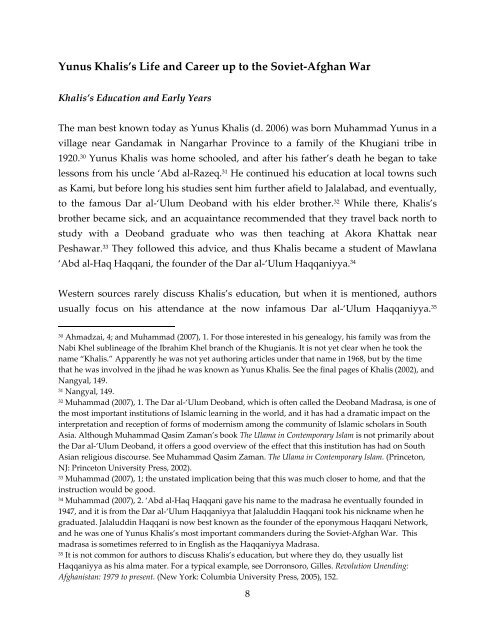Usama bin Ladin’s “Father Sheikh”:
Usama bin Ladin’s “Father Sheikh”:
Usama bin Ladin’s “Father Sheikh”:
You also want an ePaper? Increase the reach of your titles
YUMPU automatically turns print PDFs into web optimized ePapers that Google loves.
Yunus Khalis’s Life and Career up to the Soviet‐Afghan War<br />
Khalis’s Education and Early Years<br />
The man best known today as Yunus Khalis (d. 2006) was born Muhammad Yunus in a<br />
village near Gandamak in Nangarhar Province to a family of the Khugiani tribe in<br />
1920. 30 Yunus Khalis was home schooled, and after his father’s death he began to take<br />
lessons from his uncle ‘Abd al‐Razeq. 31 He continued his education at local towns such<br />
as Kami, but before long his studies sent him further afield to Jalalabad, and eventually,<br />
to the famous Dar al‐‘Ulum Deoband with his elder brother. 32 While there, Khalis’s<br />
brother became sick, and an acquaintance recommended that they travel back north to<br />
study with a Deoband graduate who was then teaching at Akora Khattak near<br />
Peshawar. 33 They followed this advice, and thus Khalis became a student of Mawlana<br />
‘Abd al‐Haq Haqqani, the founder of the Dar al‐‘Ulum Haqqaniyya. 34<br />
Western sources rarely discuss Khalis’s education, but when it is mentioned, authors<br />
usually focus on his attendance at the now infamous Dar al‐‘Ulum Haqqaniyya. 35<br />
30 Ahmadzai, 4; and Muhammad (2007), 1. For those interested in his genealogy, his family was from the<br />
Nabi Khel sublineage of the Ibrahim Khel branch of the Khugianis. It is not yet clear when he took the<br />
name “Khalis.” Apparently he was not yet authoring articles under that name in 1968, but by the time<br />
that he was involved in the jihad he was known as Yunus Khalis. See the final pages of Khalis (2002), and<br />
Nangyal, 149.<br />
31 Nangyal, 149.<br />
32 Muhammad (2007), 1. The Dar al‐‘Ulum Deoband, which is often called the Deoband Madrasa, is one of<br />
the most important institutions of Islamic learning in the world, and it has had a dramatic impact on the<br />
interpretation and reception of forms of modernism among the community of Islamic scholars in South<br />
Asia. Although Muhammad Qasim Zaman’s book The Ulama in Contemporary Islam is not primarily about<br />
the Dar al‐‘Ulum Deoband, it offers a good overview of the effect that this institution has had on South<br />
Asian religious discourse. See Muhammad Qasim Zaman. The Ulama in Contemporary Islam. (Princeton,<br />
NJ: Princeton University Press, 2002).<br />
33 Muhammad (2007), 1; the unstated implication being that this was much closer to home, and that the<br />
instruction would be good.<br />
34 Muhammad (2007), 2. ‘Abd al‐Haq Haqqani gave his name to the madrasa he eventually founded in<br />
1947, and it is from the Dar al‐‘Ulum Haqqaniyya that Jalaluddin Haqqani took his nickname when he<br />
graduated. Jalaluddin Haqqani is now best known as the founder of the eponymous Haqqani Network,<br />
and he was one of Yunus Khalis’s most important commanders during the Soviet‐Afghan War. This<br />
madrasa is sometimes referred to in English as the Haqqaniyya Madrasa.<br />
35 It is not common for authors to discuss Khalis’s education, but where they do, they usually list<br />
Haqqaniyya as his alma mater. For a typical example, see Dorronsoro, Gilles. Revolution Unending:<br />
Afghanistan: 1979 to present. (New York: Columbia University Press, 2005), 152.<br />
8


